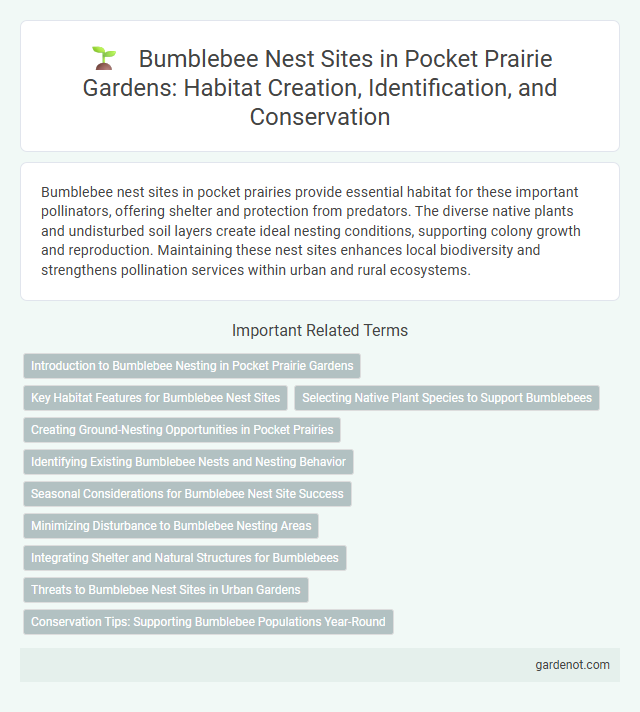Bumblebee nest sites in pocket prairies provide essential habitat for these important pollinators, offering shelter and protection from predators. The diverse native plants and undisturbed soil layers create ideal nesting conditions, supporting colony growth and reproduction. Maintaining these nest sites enhances local biodiversity and strengthens pollination services within urban and rural ecosystems.
Introduction to Bumblebee Nesting in Pocket Prairie Gardens
Bumblebee nesting in pocket prairie gardens plays a crucial role in supporting local ecosystems by providing essential habitats for queen bees. These compact, diverse plantings offer abundant forage and suitable nesting materials, enhancing bumblebee population stability. Creating suitable nest sites within pocket prairies helps promote pollination and biodiversity in urban and suburban environments.
Key Habitat Features for Bumblebee Nest Sites
Bumblebee nest sites require key habitat features such as well-drained soil with dense vegetation cover for protection and easy access to floral resources within a 300-meter radius to support foraging. Nesting typically occurs in undisturbed locations like abandoned rodent burrows, grass tussocks, or under leaf litter, which provide insulation and shelter from predators. Maintaining diverse plant species and natural ground cover in pocket prairies enhances the availability of suitable nesting sites and boosts bumblebee population sustainability.
Selecting Native Plant Species to Support Bumblebees
Selecting native plant species such as goldenrod, wild bergamot, and purple coneflower provides essential nectar and pollen resources for bumblebees throughout their active seasons. These plants support bumblebee nest sites by creating a diverse habitat that offers shelter and foraging opportunities critical for colony survival. Incorporating native flowering plants with staggered bloom times enhances ecosystem stability and promotes healthy bumblebee populations in pocket prairie environments.
Creating Ground-Nesting Opportunities in Pocket Prairies
Creating ground-nesting opportunities in pocket prairies involves maintaining bare soil patches and minimizing disturbance to provide bumblebees with suitable nesting sites. Incorporating diverse native plant species supports a stable food supply, encouraging bumblebee colonies to establish nests within these microhabitats. Strategic management such as limiting heavy foot traffic and avoiding pesticide use enhances the viability of ground nests in pocket prairie environments.
Identifying Existing Bumblebee Nests and Nesting Behavior
Bumblebee nests are typically found in abandoned rodent burrows, grass tussocks, or compost piles within a pocket prairie habitat, providing essential shelter and warmth for colony development. Nesting behavior involves queens selecting secluded, insulated sites early in spring to establish colonies, with worker bees later expanding and maintaining the nest structure. Observing floral diversity and soil disturbance in pocket prairies helps accurately identify active bumblebee nest sites critical for conservation efforts.
Seasonal Considerations for Bumblebee Nest Site Success
Bumblebee nest site success in pocket prairies depends heavily on seasonal timing, with late spring and early summer offering optimal conditions for colony establishment as temperatures rise and floral resources become abundant. Choosing nesting sites near early-blooming plants ensures access to pollen and nectar critical for queen survival and larval development. Maintaining undisturbed ground cover through seasonal management supports overwintering queens and enhances nest insulation during colder months.
Minimizing Disturbance to Bumblebee Nesting Areas
Bumblebee nest sites in pocket prairies require careful protection to preserve their ecological role in pollination. Minimizing disturbance involves avoiding soil compaction and limiting human or pet traffic near nesting areas during active seasons. Maintaining native vegetation and providing undisturbed ground cover supports bumblebee nesting success and overall population health.
Integrating Shelter and Natural Structures for Bumblebees
Integrating shelter and natural structures within a pocket prairie significantly enhances bumblebee nest site availability by mimicking their preferred habitats such as tussock grasses, leaf litter, and abandoned rodent burrows. Providing diverse nesting materials like hollow stems, dense vegetation patches, and ground cavities supports critical bumblebee lifecycle stages and improves colony establishment success. These naturalized features increase pollination efficiency by sustaining robust bumblebee populations essential to ecosystem health and agricultural productivity.
Threats to Bumblebee Nest Sites in Urban Gardens
Bumblebee nest sites in urban gardens face significant threats from habitat fragmentation and pesticide exposure, which reduce available nesting resources and affect colony health. Soil compaction and frequent garden maintenance disturb underground nests, leading to abandonment or decreased reproductive success. Urbanization pushes bumblebees into fragmented green spaces, limiting foraging options and increasing vulnerability to predators and environmental stressors.
Conservation Tips: Supporting Bumblebee Populations Year-Round
Creating and maintaining diverse flowering habitats with native plants provides essential food sources for bumblebees throughout all seasons. Leaving patches of undisturbed soil and brush piles encourages safe nesting sites while minimizing pesticide use protects these pollinators from harmful toxins. Providing water sources and ensuring connectivity between habitats enhances bumblebee population resilience and supports pollination services in pocket prairies.
Bumblebee nest site Infographic

 gardenot.com
gardenot.com